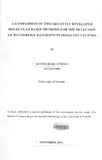| dc.description.abstract | Different mosquito species incriminated as vectors for lymphatic filariasis include several mosquitoes in the genera Anopheles, Culex and Aedes. Monitoring the infection rates of these vectors may serve as an indicator of the disease in human populations. The classical method of diagnosis of infection in mosquitoes is dissection which is both insensitive and labour intensive.
A cross-sectional study was carried out in three villages of the Tana Delta district to determine infection rates of Wuchereria bancrofii in mosquito vectors. Out of 100 female mosquitoes randomly selected from each of the three villages and dissected to determine larvae infection status, only 1 mosquito had third stage larva of W bancrofti.
In order to determine infection rates, two recently developed diagnostic tests: a peR assay and a dot blot hybridization using radioactive probes were used to analyze DNA extracted from the individually dissected mosquitoes and to determine the proportion of mosquitoes positive for W bancrofti infection. Results showed 2 out of the 300 mosquitoes analysed by peR were positive for W bancrofti infection. Analysis using 32p dot blot hybridization gave results similar to those obtained by peR based assay.
There was no significant difference in the proportion of mosquito DNA samples positive for W bancrofti infection using 32p dot blot hybridization and using peR based assay. Therefore, both peR and 32p dot blot hybridization are effective and efficient in detecting W bancrofti infection in mosquitoes, making them useful as monitoring tools in the effort to eliminate lymphatic filariasis. The study also suggests that vector infection and infectivity rates could be used to determine the relative prevalence of the infection in humans from an affected area. | en_US |

